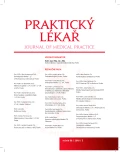Optoelectronic scaning as a tool for lower extremity anthropometric measurements
Authors:
O. Machaczka 1,2; M. Homza 3; P. Polievka 4; A. Zatloukalová 1,2; J. Janoutová 5; V. Janout 5
Authors‘ workplace:
Centrum epidemiologického výzkumu, Lékařská fakulta, Ostravská univerzita, Ostrava
Ředitel: RNDr. Vítězslav Jiřík, Ph. D.
1; Ústav epidemiologie a ochrany veřejného zdraví, Lékařská fakulta, Ostravská univerzita, Ostrava
Vedoucí: doc. MUDr. Rastislav Maďar, PhD., MBA, FRCPS.
2; Fakultní nemocnice Ostrava, Kardiovaskulární oddělení, Ostrava
Primář: MUDr. Miroslav Homza, MBA
3; DEONA MEDI s. r. o., Valašské Meziříčí
Jednatel: MUDr. Peter Polievka
4; Centrum vědy a výzkumu, Fakulta zdravotnických věd, Univerzita Palackého, Olomouc
Ředitel: prof. MUDr. David Školoudík, Ph. D.
5
Published in:
Prakt. Lék. 2018; 98(3): 121-126
Category:
Of different specialties
Overview
Background:
Modern optoelectronic methods are used in various sectors to precisely measure surface areas of objects. Building on previous experiences, the BS04 optoelectronic scanner has been constructed for contactless measurements of the human body surface area.
Objective:
The main objective of the study was to verify the feasibility and suitability of the BS04 for use in healthcare and to compare differences in the measurement of the antropometric dimensions of the lower limbs extremities the optoelectronic method and the manual measurement.
Methods:
First, a pilot study was carried out to verify the procedure of measurement of the lower extremities dimensions using BS04. Then, a total of 72 series of repeated automated and 144 series of repeated manual measurements were performed in 24 volunteers at 14 measurement points located on the lower extremities. A pairwise t-test for difference values was used to compare the results. Statistical significance was assessed at 5% level.
Results:
The comparison showed statistically significant differences in all cases. The mean difference between ranges from –3.20 to –0.47 cm (min. –6.58 cm, max. 0.78 cm). On average, the values obtained by BS04 were higher than by manual measurements. Certain limitations were found that, for the time being, prevent full use of the BS04 in the entire population, particularly immobile individuals.
Conclusions:
A huge prospect of using this device lies in the prevention and early detection of onset swelling of various causes, also in differential diagnosis and treatment of lower limb swelling due to venous insufficiency, lymphatic disorders of the lower limb vascular vessels or disorders of fat metabolism. Last but not least, this device is potentially of great importance in the design of orthopedic, compressible and other therapeutic medical devices. From this point of view, the exact values measured by the BS04 would allow the construction of medical aids with adequate mild compression even for diabetic patients.
Keywords:
optoelectronic body scanner – manual measurements – anthropometry – lower extremities
Sources
1. Cau N, Galli M, Cimolin V, et al. Comparative study between circumferential method and laser scanner 3D method for the evaluation of arm volume in healthy subjects. J Vasc Surg Venous Lymphat Disord 2016; 4(1): 64–72.
2. Daanen HAM, Ter Haar FB. 3D whole body scanners revisited. Displays 2013; 34(4): 270–275.
3. Hidding JT, Viehoff PB, Beurskens CHG, et al. Measurement properties of instruments for measuring of lymphedema: systematic review. Phys Ther 2016; 96(12): 1965–1981.
4. Chromy A. Application of high-resolution 3D scanning in medical volumetry. IJET 2016; 62(1): 23–31.
5. Karetová D, Muchová I. Kompresivní léčba žilních chorob. REMEDIA 2008; 18(2): 155–159.
6. Kičmer M, Stančík V, Polievka P, a kol. Užití optoelektroniky k měření lidského těla. Automa 2013; 19(10): 58–59.
7. Maylia E, Fairclough JA, Nokes LDM, Jones MD. Can thigh girth be measured accurately? A preliminary investigation. J Sport Rehabil 1999; 8: 43–49.
8. Deutsches Institut für Gütesicherung und Kennzeichnung e.V. Medical Compression Hosiery: Quality Assurance RAL-GZ 387/1 [online]. Dostupné z: http://www.tagungsmanagement.org/icc/images/stories/PDF/ral_gz_387_englisch.pdf [cit. 2018-01-29].
9. Ramelet AA. Compression Therapy. Dermatol Surg 2002; 28(1): 6–10.
10. Tewari N, Gill PG, Bochner MA, Kollias J. Comparison of volume displacement versus circumferential arm measurements for lymphoedema: implications for the SNAC trial. ANZ J Surg 2008; 78(10): 889–893.
11. Warren AG, Brorson H, Borud LJ, Slavin SA. Lymphedema: a comprehensive review. Ann Plast Surg 2007; 59(4): 464–472.
12. Wu SC, Crews RT, Skratsky M, et al. Control of lower extremity edema in patients with diabetes: double blind randomized controlled trial assessing the efficacy of mild compression diabetic socks. Diabetes Res Clin Pract 2017; 127: 35–43.
13. Yu CY, Lo YH, Chiou WK. The 3D scanner for measuring body surface area: a simplified calculation in the Chinese adult. Appl Ergon 2003; 34(3): 273–278
Labels
General practitioner for children and adolescents General practitioner for adultsArticle was published in
General Practitioner

2018 Issue 3
- Memantine Eases Daily Life for Patients and Caregivers
- Metamizole vs. Tramadol in Postoperative Analgesia
- Metamizole at a Glance and in Practice – Effective Non-Opioid Analgesic for All Ages
- Memantine in Dementia Therapy – Current Findings and Possible Future Applications
- What Effect Can Be Expected from Limosilactobacillus reuteri in Mucositis and Peri-Implantitis?
Most read in this issue
- Preoperative anaemia: prevalence, causes, consequences, and management
- Overview of questionnaires and scales of the motor symptoms of patients with Parkinson’s disease
- Treatment of immunodeficiency by subcutaneous immunoglobulins
- Basics of respiratory physiotherapy for general practitioners
